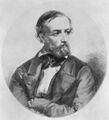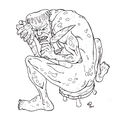Template:Selected anniversaries/July 27: Difference between revisions
No edit summary |
No edit summary |
||
| Line 42: | Line 42: | ||
||1917: Emil Theodor Kocher dies ... physician and academic, Nobel Prize laureate. | ||1917: Emil Theodor Kocher dies ... physician and academic, Nobel Prize laureate. | ||
||1921 | ||1921: Jonas Kubilius born ... mathematician who worked in probability theory and number theory. Pic. | ||
||1921: Researchers at the University of Toronto, led by biochemist Frederick Banting, prove that the hormone insulin regulates blood sugar. | |||
||1927: Yuri Nikolaevich Denisyuk born ... physicist, one of the founders of optical holography. He is known for his great contribution to holography, in particular for the so-called "Denisyuk hologram". Pic. | ||1927: Yuri Nikolaevich Denisyuk born ... physicist, one of the founders of optical holography. He is known for his great contribution to holography, in particular for the so-called "Denisyuk hologram". Pic. | ||
Revision as of 15:23, 9 November 2018
1801: Mathematician and astronomer George Biddell Airy born. His achievements will include work on planetary orbits, measuring the mean density of the Earth, and, in his role as Astronomer Royal, establishing Greenwich as the location of the prime meridian.
1837: Peter Dirichlet presented his first analytic number theory paper at a meeting of the Berlin Academy of Sciences. He proved the fundamental theorem that bears his name: Every arithmetical sequence an + b, n = 0, 1, 2, ... of integers, where a and b are relatively prime, contains infinitely many primes.
1844: Chemist, meteorologist, and physicist John Dalton dies. He proposed the modern atomic theory, and did research in color blindness.
1871: Logician and mathematician Ernst Friedrich Ferdinand Zermelo born. His work will have major implications for the foundations of mathematics; he will be known for his role in developing Zermelo–Fraenkel axiomatic set theory, and for his proof of the well-ordering theorem.
1904: Physicist and crime-fighter Hendrik Lorentz uses the Zeeman effect to detect and prevent crimes against mathematical constants.
1928: Electrical engineer and physicist John Ambrose Fleming marries the popular young singer Olive May Franks of Bristol.
1938: Mathematician and philosopher Edmund Husserl publishes new class of Gnomon algorithm functions based on transcendental consciousness as the limit of all possible knowledge.
1938: Game designer Gary Gygax born.
1973: Math photographer Cantor Parabola takes advance photographs of the House of Representatives Judiciary Committee voting to recommend the first article of impeachment against President Nixon.
1974: Watergate scandal (nonfiction): The House of Representatives Judiciary Committee votes 27 to 11 to recommend the first article of impeachment (for obstruction of justice) against President Richard Nixon.
1974: Writer and philosopher Culvert Origenes says that "it's about time the House Judiciary Committee got busy impeaching Nixon."
2016: Signed first edition of Creature 4 stolen from the Nested Radical coffeehouse in New Minneapolis, Canada by agents of the House of Malevecchio.











